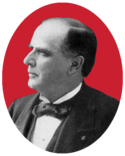| 1896 presidential election | |
  Nominees McKinley and Hobart | |
| Convention | |
|---|---|
| Date(s) | June 16–18, 1896 |
| City | St. Louis, Missouri |
| Chair | John M. Thurston |
| Candidates | |
| Presidential nominee | William McKinley of Ohio |
| Vice-presidential nominee | Garret A. Hobart of New Jersey |
| Voting | |
| Total delegates | 924 |
| Votes needed for nomination | 463 |
| Results (president) | McKinley (OH): 661.5 (71.59%) Reed (ME): 84.5 (9.15%) Quay (PA): 61.5 (6.66%) Morton (NY): 58 (6.28%) Allison (IA): 35.5 (3.84%) Not Voting: 22 (2.38%) Cameron (PA): 1 (0.11%) |
| Ballots | 1 |

The 1896 Republican National Convention was held in a temporary structure south of the St. Louis City Hall in Saint Louis, Missouri, from June 16 to June 18, 1896.
Former Governor William McKinley of Ohio was nominated for president on the first ballot with 661½ votes to 84½ for House Speaker Thomas Brackett Reed of Maine, 61½ votes for Senator Matthew S. Quay of Pennsylvania, 58 votes for Governor Levi P. Morton of New York who was vice president (1889–1893) under President Benjamin Harrison. New Jersey banker Garret A. Hobart was nominated for vice president over Henry Clay Evans of Tennessee. Joseph B. Foraker of Ohio placed McKinley's name in nomination.
The convention was originally slated for the St. Louis Exposition and Music Hall. However it was determined that repairs and upgrading the Hall could not be done in time and so a temporary wood convention hall was built in 60 days at a cost of $60,000 on the lawn south of City Hall which was under construction.[1] At the conclusion of the convention, both the temporary building as well as the original Exposition Hall were torn down and a new Coliseum was built.
The 1896 Convention was held in St. Louis less than a month after the infamous 1896 tornado that devastated a large swath of the city and killed at least 255 people. There was speculation that it might be unfeasible to hold the convention in the city, but, after a concerted cleanup effort was undertaken, the convention went ahead as planned.